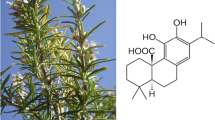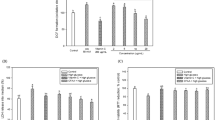Abstract
Recent findings suggest that mitochondrial membrane fluidity could influence mitochondrial energy metabolism. β-sitosterol (BS) is a common plant sterol that is prevalent in plant oils, nuts, cereals and plant food products. Its chemical structure is very similar to that of cholesterol. As a cholesterol analog, BS is highly lipid soluble and largely resides in the membranes of cells or organelles where it may have an influence on the membrane fluidity. The present study reports that, with the cholesterol chelator 2-hydroxypropyl-β-cyclodextrin (HPβCD) as its carrier, BS is able to increase the fluidity of the inner mitochondrial membrane (IMM) without affecting the fluidity of the outer mitochondrial membrane (OMM), and consequently to increase the mitochondrial membrane potential (∆Ψm) and mitochondrial ATP content. It has been previously proposed that a therapeutical boost in adenosine triphosphate (ATP) levels in mitochondria may be beneficial for neurodegenerative diseases such as Alzheimer’s disease (AD). Given that dietary administration of plant sterols could increase brain BS concentrations, these results may provide a better understanding of the beneficial effects of plant sterol-enriched nutrients on neurodegenerative diseases such as AD.
Similar content being viewed by others
References
Ames A (2000) CNS energy metabolism as related to function. Brain Res Brain Res Rev 34(1–2):42–68
Awad AB, Toczek J, Fink CS (2004) Phytosterols decrease prostaglandin release in cultured P388D1/MAB macrophages. Prostaglandins Leukot Essent Fatty Acids 70(6):511–520
Devi L, Prabhu BM, Galati DF, Avadhani NG, Anandatheerthavarada HK (2006) Accumulation of amyloid precursor protein in the mitochondrial import channels of human Alzheimer’s disease brain is associated with mitochondrial dysfunction. J Neurosci 26(35):9057–9068
Erecinska M, Cherian S, Silver IA (2004) Energy metabolism in mammalian brain during development. Prog Neurobiol 73(6):397–445
Felty Q, Roy D (2005) Estrogen, mitochondria, and growth of cancer and non-cancer cells. J Carcinog 4(1):1
Gibson GE, Sheu KF, Blass JP (1998) Abnormalities of mitochondrial enzymes in Alzheimer disease. J Neural Transm 105(8–9):855–870
Gotow T, Shibata M, Kanamori S et al (2000) Selective localization of Bcl-2 to the inner mitochondrial and smooth endoplasmic reticulum membranes in mammalian cells. Cell Death Differ 7(7):666–674
Jansen PJ, Lütjohann D, Abildayeva K et al (2006) Dietary plant sterols accumulate in the brain. Biochim Biophys Acta 1761(4):445–453
Kann O, Kovács R (2007) Mitochondria and neuronal activity. Am J Physiol Cell Physiol 292(2):C641–C657
Liu J, Li L, Suo WZ (2009) HT22 hippocampal neuronal cell line possesses functional cholinergic properties. Life Sci 84(9–10):267–271
Loew LM, Carrington W, Tuft RA, Fay FS (1994) Physiological cytosolic Ca2+ transients evoke concurrent mitochondrial depolarizations. Proc Natl Acad Sci USA 91(26):12579–12583
Martinez-Seara H, Róg T, Pasenkiewicz-Gierula M, Vattulainen I, Karttunen M, Reigada R (2008) Interplay of unsaturated phospholipids and cholesterol in membranes: effect of the double-bond position. Biophys J 95(7):3295–3305
Maurer I, Zierz S, Möller HJ (2000) A selective defect of cytochrome c oxidase is present in brain of Alzheimer disease patients. Neurobiol Aging 21(3):455–462
Mayevsky A, Chance B (1975) Metabolic responses of the awake cerebral cortex to anoxia hypoxia spreading depression and epileptiform activity. Brain Res 98(1):149–165
Parker WD Jr, Filley CM, Parks JK (1990) Cytochrome oxidase deficiency in Alzheimer’s disease. Neurology 40(8):1302–1303
Reddy PH (2009) Role of mitochondria in neurodegenerative diseases: mitochondria as a therapeutic target in Alzheimer’s disease. CNS Spect 8(Suppl 7):8–13, discussion 16–18
Reddy PH, Beal MF (2008) Amyloid beta, mitochondrial dysfunction and synaptic damage: implications for cognitive decline in aging and Alzheimer’s disease. Trends Mol Med 14(2):45–53
Schon EA, Manfredi G (2003) Neuronal degeneration and mitochondrial dysfunction. J Clin Invest 111(3):303–312
Shi C, Xu XW, Forster EL, Tang LF, Ge Z, Yew DT, Xu J (2008) Cell Biochem Funct 26(2):172–178
Silver I, Erecinska M (1998) Oxygen and ion concentrations in normoxic and hypoxic brain cells. Adv Exp Med Biol 454:7–16
Smith MA, Perry G, Richey PL et al (1996) Oxidative damage in Alzheimer’s. Nature 382(6587):120–121
Vanmierlo T, Weingärtner O, van der Pol S et al (2012) Dietary intake of plant sterols stably increases plant sterol levels in the murine brain. J Lipid Res 53(4):726–735
Yao K, Wu W, Yu Y et al (2008) Effect of superposed electromagnetic noise on DNA damage of lens epithelial cells induced by microwave radiation. Invest Ophthalmol Vis Sci 49(5):2009–2015
Author information
Authors and Affiliations
Corresponding author
Additional information
Chun Shi and Fengming Wu contributed equally to these work.
Rights and permissions
About this article
Cite this article
Shi, C., Wu, F. & Xu, J. Incorporation of β-sitosterol into mitochondrial membrane enhances mitochondrial function by promoting inner mitochondrial membrane fluidity. J Bioenerg Biomembr 45, 301–305 (2013). https://doi.org/10.1007/s10863-012-9495-3
Received:
Accepted:
Published:
Issue Date:
DOI: https://doi.org/10.1007/s10863-012-9495-3




